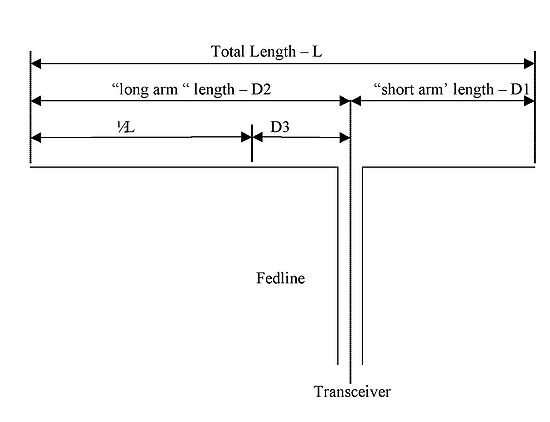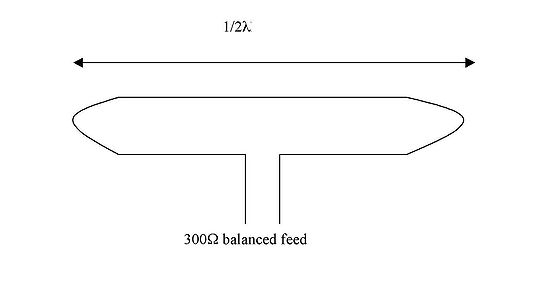Dipole: Difference between revisions
(Various minor updates to read better. Added 31 metres as length of G5RV.) |
(changed page link to match existing page) |
||
| Line 33: | Line 33: | ||
Although the G5RV is not a 1/2 wave dipole like those described above, this antenna (invented by Louis Varney, callsign G5RV) shares some physical characteristics with a centre-fed dipole. The main difference between a dipole and G5RV is that the transmission line of a G5RV is part of the [[impedance matching|matching]] section that allows operation over a number of bands. Although the G5RV can be used on [[20 metres]] without an [[antenna tuner]], a tuner is necessary to use it on other bands. | Although the G5RV is not a 1/2 wave dipole like those described above, this antenna (invented by Louis Varney, callsign G5RV) shares some physical characteristics with a centre-fed dipole. The main difference between a dipole and G5RV is that the transmission line of a G5RV is part of the [[impedance matching|matching]] section that allows operation over a number of bands. Although the G5RV can be used on [[20 metres]] without an [[antenna tuner]], a tuner is necessary to use it on other bands. | ||
There are several different variations on the G5RV. The most well-known is fed through 450-ohm [[ladder line]] 10.6 metres (34.8 feet) long, with one end of the ladder line connected at the centre-feed point of the antenna and the other connected through a [[balun]] to 50-ohm [[ | There are several different variations on the G5RV. The most well-known is fed through 450-ohm [[ladder line]] 10.6 metres (34.8 feet) long, with one end of the ladder line connected at the centre-feed point of the antenna and the other connected through a [[balun]] to 50-ohm [[Coaxial Cable]] [[feedline]]. An alternative is to run [[balanced feedline]] (such as [[twin-lead]] or [[ladder line]]) all the way from the antenna [[feedpoint]] to the [[antenna tuner]]. The latter arrangement can be very effective, but not all lengths of [[feedline]] will tune properly. (See detailed discussion on [[feedline|feedlines]].) Standard G5RV antennas are 31 metres (102 feet) long (excluding feedline and matching section length), and can be used on [[80 metres|80]], [[40 metres|40]], [[20 metres|20]], [[15 metres|15]], and [[10 metres]]. A half-length G5RV 51 feet long can be used on [[40 metres|40]], [[20 metres|20]], [[15 metres|15]], and [[10 metres|10]]; this variation is known as the '''G5RV jr'''. | ||
Excellent analyses of the G5RV have been written by [http://www.cebik.com/wire/g5rv.html W4RNL] and [http://www.vk1od.net/G5RV/ VK1OD]. Philip Grimshaw (VK4KVK) has written a comprehensive [http://www.grimshaw.net.au/vkg5rvhb.html book] on the G5RV. | Excellent analyses of the G5RV have been written by [http://www.cebik.com/wire/g5rv.html W4RNL] and [http://www.vk1od.net/G5RV/ VK1OD]. Philip Grimshaw (VK4KVK) has written a comprehensive [http://www.grimshaw.net.au/vkg5rvhb.html book] on the G5RV. | ||
Revision as of 01:47, 3 July 2008
Dipole antennas are "two-sided' in that they are fed from a point between the two ends. In its simplest form, a dipole will be centre-fed, with the total length being a half-wavelength at the frequency of transmission.
Centre-fed half-wave dipole
Dipole length for resonance is calculated using either:
<math>L = \frac {468}{frequency(MHz)}</math> for total length in feet, or,
<math>L = \frac {285}{frequency(MHz)}</math> for total length in metres.
Half-wave centre-fed dipoles with each leg 1/4 wavelength long are perhaps the most common antennas used in amateur radio. They are an example of a balanced antenna which does not require a centerpoise or other RF ground.
These 1/2 wave dipoles can be used on their odd harmonics as well as their fundamental resonant frequencies. For example, the amateur 40 metre band begins at 7 MHz. The 3rd harmonic is 3 x 7 = 21 MHz, where the 15 metre band begins. Thus a centre-fed dipole that is a half-wavelength long at 40 metres (approximately 20 metres long, or 66 feet) can also be used as a 15 metre antenna.
Off-centre-fed dipole (OCF dipole)
As the name suggests, the OCF dipole is not fed from the centre. The advantage of a 1/2 wave OCF dipole fed 1/3 of the way from one end is that it can be used on the fundamental frequency and its even harmonics. Since most amateur bands are even harmonics of other amateur bands, this is a useful features. An OCF that is 1/2 wavelength long on 80 metres (40 metres long, or 132 feet) can be used on 80, 40, 20, or 10 metres.
L is calculated from the formulae above. The dimensions D1, D2 and D3 are found using:
<math>D1 = 0.38L</math>
<math>D2 = 0.62L</math>
<math>D3 = 0.14L</math>
G5RV antenna
Although the G5RV is not a 1/2 wave dipole like those described above, this antenna (invented by Louis Varney, callsign G5RV) shares some physical characteristics with a centre-fed dipole. The main difference between a dipole and G5RV is that the transmission line of a G5RV is part of the matching section that allows operation over a number of bands. Although the G5RV can be used on 20 metres without an antenna tuner, a tuner is necessary to use it on other bands.
There are several different variations on the G5RV. The most well-known is fed through 450-ohm ladder line 10.6 metres (34.8 feet) long, with one end of the ladder line connected at the centre-feed point of the antenna and the other connected through a balun to 50-ohm Coaxial Cable feedline. An alternative is to run balanced feedline (such as twin-lead or ladder line) all the way from the antenna feedpoint to the antenna tuner. The latter arrangement can be very effective, but not all lengths of feedline will tune properly. (See detailed discussion on feedlines.) Standard G5RV antennas are 31 metres (102 feet) long (excluding feedline and matching section length), and can be used on 80, 40, 20, 15, and 10 metres. A half-length G5RV 51 feet long can be used on 40, 20, 15, and 10; this variation is known as the G5RV jr.
Excellent analyses of the G5RV have been written by W4RNL and VK1OD. Philip Grimshaw (VK4KVK) has written a comprehensive book on the G5RV.
Folded Dipole
Folded dipoles are also 1/2 wavelength long. (The Greek letter <math>\lambda</math> is commonly used to represent wavelength.) However, the radiating elements are made of two parallel wires that are connected at the ends, and the feedpoint is at the centre of one of the two wires. The advantage of the folded dipole is that its impedance is about 300 ohms, allowing it to be fed with a 300-ohm balanced line. It is possible to make both the radiating elements and the feedline from 300-ohm twinlead, although some type of antenna tuner or matching section will be required to transform the impedance to 50 ohms at the transceiver.
These antennas are commonly used on FM repeaters on VHF bands, although care should be taken using 300-ohm twinlead at VHF and higher frequencies. (See discussion on feedline.)
Another advantage of a folded dipole is that it has a wide usable bandwidth, allowing it to cover more of the band. However, folded dipoles cannot be used as part of a fan dipole, and unlike conventional single-wire dipoles, they cannot be used on their odd harmonics. (Both of these limitations occur because conventional dipoles have higher impedance away from their resonant frequencies and reach minimum impedance at resonance, while folded dipoles have lower impedance away from resonance and approach maximum impedance at resonance. At DC, a folded dipole is a direct short across the feedpoint, while a conventional dipole is an open circuit.)
Fan Dipole
Several dipoles with different lengths, each of which is resonant on a different band, can be connected together at a common feedpoint and fed with a single feedline. This is known as a fan dipole. The radiating elements of the dipoles should not run parallel to each other.
Each of the dipole element pairs A, B and C in this diagram would usually be cut for a a frequency in the centre of the required amateur band. The total length of each dipole pair is 1/2<math>\lambda</math>.
Approximate total lengths of dipole elements
| Amateur band | total length (feet) | total length (metres) |
| 80 metre band | 120 feet | 37 metres |
| 40 metre band | 66 feet | 20 metres |
| 20 metre band | 33 feet | 10.2 metres |
| 10 metre band | 16.5 feet | 5.0 metres |
Other Dipole Variants
"Rabbit ears" dipoles are commonly used for TV reception. The position and length of the dipole arms can be adjusted to optimise reception.



